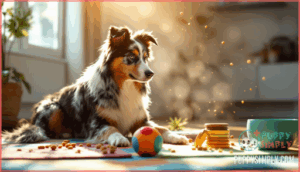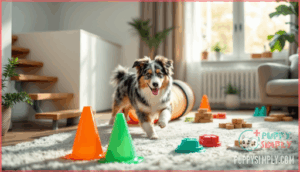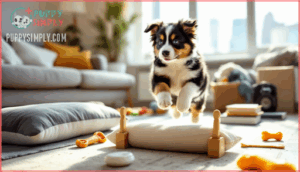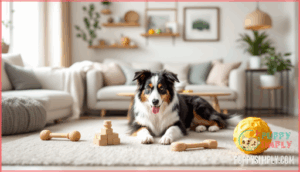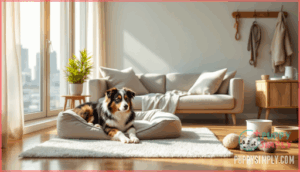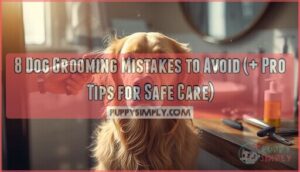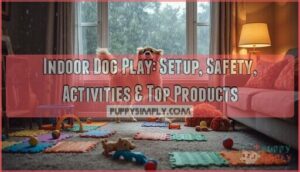This site is supported by our readers. We may earn a commission, at no cost to you, if you purchase through links.

But is that really true? These energetic, intelligent dogs do demand significant daily exercise and mental stimulation, usually around two hours of physical activity for adults. The real question isn’t about square footage—it’s whether you can commit to meeting their needs consistently.
Australian Shepherds can adapt to apartment living when their physical and mental requirements are met through structured exercise, training, and enrichment. Success depends less on your living space and more on your ability to provide the active lifestyle this breed requires.
Table Of Contents
Key Takeaways
- Australian Shepherds can successfully adapt to apartment living if you commit to meeting their substantial daily exercise requirements—roughly two hours of physical activity for adults—and provide consistent mental stimulation through puzzle toys, training, and enrichment activities.
- Success in apartments depends far more on your lifestyle commitment than square footage, as only 18% of Aussies are genuinely hyperactive while most thrive with proper routines regardless of living space size.
- Training becomes critical in apartments and must address specific challenges like house training without yard access, managing barking triggered by hallway noise and neighbors, and preventing separation anxiety through gradual independence exercises.
- Health management in smaller spaces requires vigilant grooming to control shedding from their double coat, awareness of breed-specific conditions like hip dysplasia and MDR1 mutation affecting 15.6% of the breed, and maintaining structured routines that prevent boredom-related destructive behaviors.
Are Australian Shepherds Good Apartment Dogs?
You might think Australian Shepherds need wide-open spaces and sprawling yards to thrive, but the reality isn’t quite that simple. While these energetic herding dogs certainly have big exercise needs, apartment living isn’t automatically off the table. Let’s clear up what’s fact and what’s fiction with respect to keeping an Aussie in smaller living quarters.
Breed Overview and Temperament
Australian Shepherds pack the heart of a ranch dog into a medium-sized frame—they’re smart, tireless, and bred to work alongside people from sunup to sundown. This breed’s history as herding dogs means their temperament centers on loyalty and responsiveness.
Here’s what defines the Australian Shepherd breed characteristics:
- Energy levels: They demand constant activity and mental challenges
- Herding instincts: They may nip at heels or circle family members
- Aussie personality: Affectionate, devoted, and willing to please
Despite their intensity, Australian Shepherds make excellent family dogs when you meet their needs.
Common Misconceptions About Aussies in Apartments
Many people believe Australian Shepherds in apartments are a recipe for disaster, but the reality isn’t so black and white. While 67% of apartment owners assume Aussies are unsuitable due to excessive energy levels, studies show these dogs adapt well when you commit to consistent routines.
The truth is, only 18% are genuinely hyperactive—most thrive with proper exercise and mental stimulation, regardless of space required. Owners should understand the breed’s need for regular vigorous exercise to guarantee a happy and healthy dog.
Exercise Needs of Australian Shepherds
Australian Shepherds weren’t bred to be couch potatoes, so their exercise needs are substantial whether you’re in a house or an apartment.
Meeting these requirements takes commitment, but it’s not impossible with the right approach. Let’s break down what your Aussie needs to stay physically and mentally healthy in smaller living spaces.
Daily Physical Activity Requirements
Regarding Australian Shepherds, exercise isn’t optional—it’s essential. Adult Aussies need at least two hours of physical activity daily, split across multiple walks and active play sessions. Puppies require roughly five minutes of exercise per month of age, while senior Aussies gradually need less as they age.
Weather conditions can impact outdoor time in apartments, so you’ll want backup plans for keeping your active dog moving year-round. Regular exercise is important for their overall heart health.
Mental Stimulation and Play
Physical workouts alone won’t cut it for this brainy breed. Australian Shepherds rank among the smartest dogs and need 30–60 minutes of focused mental stimulation daily.
Puzzle toys, scent work, and trick training sessions burn mental energy effectively—even in apartments. Rotating toys weekly keeps things fresh, and many owners find that dog sports provide the mental challenge their Aussie craves.
Without adequate mental play, you’re likely to see destructive behaviors emerge.
Exercise Ideas for Apartment Living
Getting creative with exercise doesn’t mean you need a backyard—it just means thinking outside the traditional walk. Try Indoor Agility setups using cones and tunnels, Stair Workouts for cardio bursts, or Treadmill Training on rainy days.
Scent Games engage their herding instincts, while Puzzle Toys blend mental stimulation with physical activity—critical for keeping Australian Shepherds thriving in apartments.
Training Australian Shepherds in Apartments
Training an Australian Shepherd in an apartment comes with unique challenges that require consistent effort and smart strategies. From establishing reliable bathroom routines to managing noise and anxiety, you’ll need to address specific behaviors that can become problems in close quarters.
Here are three essential training areas to focus on when raising your Aussie in an apartment setting.
House Training and Toilet Routines
House training an Australian Shepherd in an apartment isn’t impossible, but it demands more vigilance and consistency than you’d need with a backyard at your disposal. Here’s what successful apartment toilet training requires:
- Take your Aussie out every 2-3 hours to establish routine consistency and prevent indoor accidents
- Use the same outdoor spot to encourage scent marking and faster recognition of appropriate toileting areas
- Pair a verbal cue like "go potty" during elimination to build reliable associations
- Immediately reward successful outdoor elimination to reinforce schedule adherence and proper habits
Managing Barking and Separation Anxiety
When your Australian Shepherd starts barking at every footstep in the hallway or whining the moment you grab your keys, you’re seeing classic signs of apartment-related stress that need immediate attention. Barking triggers in apartments include noise from neighbors, door sounds, and visual stimuli through windows.
Independence training helps Australian Shepherds cope with separation anxiety—start by leaving for just 30 seconds, then gradually increase the duration. Calming techniques like white noise machines and treat-dispensing toys reduce behavioral issues during routine changes.
| Anxiety Signs | Calming Techniques | Training Steps |
|---|---|---|
| Excessive barking | White noise machines | 30-second departures |
| Destructive chewing | Treat-dispensing toys | Gradual time increases |
| Pacing and whining | Consistent routines | Reward calm behavior |
Socialization and Crate Training
Your Australian Shepherd won’t thrive in an apartment bubble—exposure to different people, dogs, and environments builds the confidence that prevents fearful or aggressive behavior down the line. Early socialization and crate training work hand-in-hand when raising an Aussie puppy in apartments:
- Schedule daily socialization outings to parks, pet stores, and busy sidewalks
- Introduce the crate as a safe den, not punishment
- Use positive reinforcement with treats during crate introduction
- Practice short crate sessions while you’re home to reduce anxiety
- Maintain consistent socialization schedules throughout their first year
Crate-trained Australian Shepherds adapt better to apartment living with structured routines.
Preventing Boredom and Behavioral Issues
When your Australian Shepherd doesn’t get enough stimulation, boredom quickly turns into destructive behavior—think chewed furniture, excessive barking, and general restlessness. Keeping an Aussie’s mind and body engaged in an apartment takes deliberate planning, but it’s absolutely manageable with the right approach.
Here are three practical strategies to prevent boredom and keep your dog mentally satisfied.
Interactive Toys and Games
Keeping your Aussie mentally sharp in an apartment isn’t about reinventing the wheel—it’s about finding the right tools that tap into their natural drive to work and problem-solve. Puzzle toys that dispense treats, like Kongs stuffed with frozen peanut butter, keep Australian Shepherds occupied while challenging their intelligence.
You can also create DIY games by hiding kibble in muffin tins covered with tennis balls, weaving training commands into play to prevent boredom and redirect their herding instincts into productive mental stimulation.
Establishing Daily Routines
Consistency isn’t just helpful for your Australian Shepherd—it’s the foundation that keeps their high-energy temperament from turning apartment life into chaos. Australian Shepherds thrive when feeding times, potty breaks, and exercise sessions happen predictably—this structure reduces anxiety and channels their working-dog instincts into manageable patterns.
For Australian Shepherds, consistent daily routines aren’t optional—they’re the framework that prevents high energy from becoming apartment chaos
- Morning walks before breakfast anchor your Aussie’s day and prevent pent-up energy from causing destructive behaviors
- Scheduled potty breaks every 4-6 hours reinforce training and minimize accidents in limited apartment spaces
- Consistent feeding times regulate digestion and make bathroom routines more predictable for apartment dwellers
- Designated play sessions give your dog socialization opportunities while teaching them when it’s time to settle down
- Evening wind-down routines signal rest time, helping high-energy Australian Shepherds shift from physical activity to calm behavior
Creative Indoor Activities
Even with a solid routine in place, your Australian Shepherd’s brain needs more than scheduled walks—they need mental workouts that challenge their herding instincts right inside your apartment. Puzzle toys, scent work, and trick training tap into their problem-solving abilities while burning energy. You can set up mini agility courses using household items or practice indoor herding games with soft toys to satisfy their working-dog nature.
These activities prevent boredom and destructive behaviors that emerge when Australian Shepherds lack adequate mental exercise in apartments.
| Activity Type | Mental Stimulation Level | Space Required |
|---|---|---|
| Agility Courses | High | Medium |
| Puzzle Toys | Moderate to High | Low |
| Scent Work | High | Low to Medium |
Health and Care Considerations in Apartments
{{
Grooming and Shedding Management
Managing that beautiful double coat in a small space can feel like fighting a losing battle with fur tumbleweeds, but a solid grooming routine keeps shedding under control and your apartment livable.
Brush your Australian Shepherd dog three to four times weekly—daily during heavy shedding seasons—using a slicker brush and undercoat rake.
Bathing needs are minimal, roughly every six to eight weeks unless they get particularly dirty. Professional grooming every few months helps manage that double coat efficiently when space limits your DIY setup.
Addressing Breed-Specific Health Issues
Australian Shepherd dog health problems deserve attention before apartment life begins. Around 10% develop hip dysplasia, 4-9% face epilepsy risks with potential cluster seizures, and hereditary cataract prevalence reaches 4-9%. The MDR1 mutation affects roughly 15.6% of the breed, causing dangerous drug sensitivity. Autoimmune diseases and allergies strike at least 10% of Aussies, requiring:
- Genetic testing before medication administration to identify MDR1 carriers
- Regular eye exams starting at age two for early cataract detection
- Joint supplements and movement monitoring for hip dysplasia management
Apartment living doesn’t worsen these dog breed health issues, but limited space makes recognizing subtle canine health changes critical.
Veterinary Care and Nutrition Needs
Your Aussie’s veterinary care needs don’t stop at diagnosis—proper nutrition and routine checkups form the backbone of apartment-based health management. Choose dog food addressing genetic predispositions like joint support for dysplasia-prone dogs.
Schedule biannual veterinarian visits for preventative care, increasing frequency for senior Aussies. Keep emergency preparedness supplies accessible since apartment dwellers face transport challenges.
Quality Australian Shepherd dog diet and nutrition directly impacts dog health and wellbeing in confined spaces.
Frequently Asked Questions (FAQs)
What size apartment is best for an Australian Shepherd?
A spacious one-bedroom (around 700+ square feet) works best, but smaller apartments can succeed with smart vertical space use and storage solutions.
Balcony access helps, though noise levels matter more than minimum square footage for Australian Shepherd apartment suitability when adapting dogs to apartment living.
Can I leave my Australian Shepherd alone in an apartment while I’m at work?
Leaving your Australian Shepherd alone requires gradual Alone Time Training to prevent
How much does it cost to raise an Aussie in an apartment?
Initial setup costs for Aussies include essentials like crates, bedding, and leashes, while ongoing expenses cover food, grooming, and veterinary care.
Budgeting tips for apartment pet ownership include planning for unexpected costs like emergency vet visits and considering pet insurance to manage dog care expenses.
Do Australian Shepherds bark more in apartments than houses?
Barking behavior is less about buildings and more about breed predisposition—Australian Shepherds bark when understimulated, regardless of location.
Apartment dogs face more barking triggers like hallway noise and proximity to neighbors, increasing noise complaints.
Training consistency and soundproofing options help manage this natural watchdog tendency in confined spaces.
Conclusion
Think of apartment living with an Australian Shepherd like running a marathon—it’s entirely doable, but only if you’re committed to the training. Whether Australian Shepherds are good apartment dogs ultimately depends on your lifestyle, not your square footage.
These herding breeds thrive when you provide consistent exercise, mental challenges, and structured routines. Without that commitment, behavioral problems will surface quickly. Your daily dedication matters far more than the size of your space.
- https://www.dogster.com/dog-health-care/how-much-exercise-does-australian-shepherd-need
- https://www.paintedblueaussies.com/blog/choosing-aussie-size
- https://petcareshed.com.au/blogs/pet-supplies/australian-shepherds-australia-guide
- https://www.petscare.com/news/post/australian-shepherd-exercise-needs-guide
- https://www.dimensions.com/element/dogs-australian-shepherd


